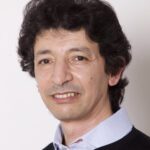Lien vers Pubmed [PMID] – 9119401
Lien vers HAL – pasteur-04036434
Lien DOI – 10.1006/geno.1996.4526
Genomics, 1997, 40 (2), pp.332-341. ⟨10.1006/geno.1996.4526⟩
Several lines of evidence indicate a crucial role for unconventional myosins in the function of the sensory hair cells of the inner ear. We report here the characterization of the cDNAs encoding two unconventional type I myosins from a mouse cochlear cDNA library. The first cDNA encodes a putative protein named Myo1c, which is likely to be the murine orthologue of the bullfrog myosin Iβ and which may be involved in the gating of the mechanotransduction channel of the sensory hair cells. This myosin belongs to the group of short-tailed myosins I, with its tail ending shortly after a polybasic, TH-1-like domain. The second cDNA encodes a novel type I myosin Myo1f which displays three regions: a head domain with the conserved ATP- and actin-binding sites, a neck domain with a single IQ motif, and a tail domain with the tripartite structure initially described in protozoan myosins I. The tail of Myo1f includes (1) a TH-1 region rich in basic residues, which may interact with anionic membrane phospholipids; (2) a TH-2 proline-rich region, expected to contain an ATP-insensitive actin-binding site; and (3) a SH-3 domain found in a variety of cytoskeletal and signaling proteins. Northern blot analysis indicated that the genes encoding Myo1c and Myo1f display a widespread tissue expression in the adult mouse.Myo1candMyo1fwere mapped byin situhybridization to the chromosomal regions 11D-11E and 17B-17C, respectively. The human orthologuous genesMYO1CandMYO1Fwere also characterized, and mapped to the human chromosomal regions 17p13 and 19p13.2–19p13.3, respectively.

